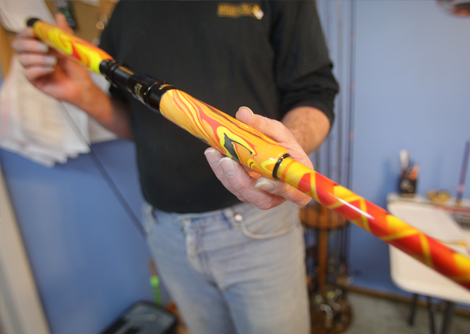It all started with tying a few flies.
In 1983, Ricky Espenschied wanted to up his fishing game for trout season, which this year started March 1. He had already been tying his own flies, angler jargon for fastening bits of thread and feathers on fly-fishing hooks. So he decided to go ahead and make the whole darn pole.
“I was catching fish on the flies that I tied, and I thought, wouldn’t it be cool if I caught fish on a rod that I built?” Espenschied said. He ended up making two rods.
Twenty-seven years later, Espenschied built five rods for family and friends. In 2012, he got a license for his rod-making business.
When Espenschied is not holed up in the workroom in his home in Fayette, Missouri, or fishing at a nearby pond, he can usually be found at MU, where he’s been a facilities attendant in Memorial Union for 14 years.
So far he has built 70 custom rods. All sales have been through word of mouth.
He starts with a rod, which can be made from a variety of materials, such as graphite, fiberglass or a mix of the two. Customers choose the kind of handle and guides they want. Espenschied then reams out the handle, attaches the guides and completes assembly.

One of the custom appointments Espenschied offers is a swirled paint treatment. Photo by Mikala Compton.
His specialty is a spiral wrap, with the first guide on the pole’s top and the rest of the guides on the bottom. “This takes some of the stress off the rod and a lot of stress off the fisherman,” Espenschied said. “It takes away some of the torque when the pole bends because the guides are on the bottom.”
Base price for Espenschied’s casting and spinning rods is $160. Rods with thread weaving carry an upcharge. Thread weaving is wrapping colored thread around a pole to create different patterns and then slathering a clear epoxy coat on top for a shiny finish.
In Espenschied’s workroom, there are a handful of brightly colored poles leaning in a corner. For more pizazz, he adds a swirled paint treatment to handles and sometimes little ornaments like feathers and monograms to the rods. It takes several days for the epoxy coats to dry. If he doesn’t like the end result, he starts over.
It takes him about a week to make a pole.
For Espenschied, making rods is more a passion than a viable business model. “If I kept track of my time, I probably wouldn’t do it anymore,” he said.
— Alaina Lancaster
